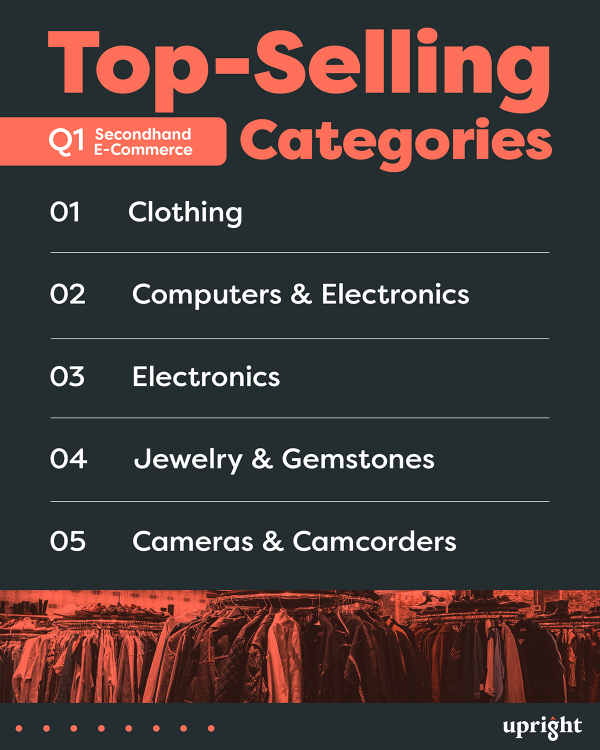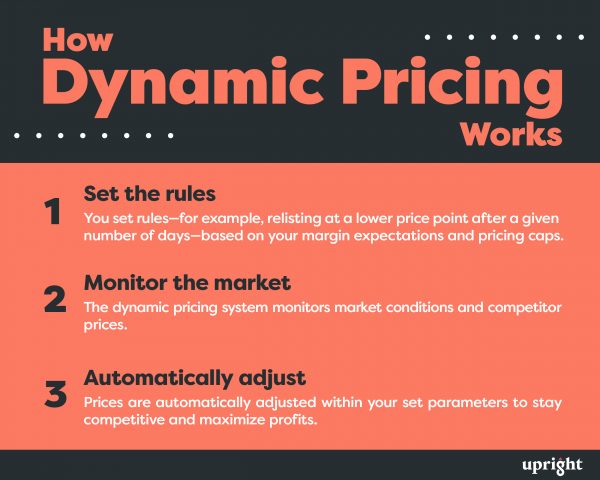Post-Holiday Slowdown? Keep the Momentum Going
We’ve exited Q4 and the holiday rush has ended.
Many secondhand e-commerce businesses are experiencing a familiar challenge—a dip in sales. Retail businesses entering Q1 of last year saw a decrease of 0.8% in sales compared to the month prior in Q4. But instead of slowing down, Q1 can be a golden opportunity to build momentum, optimize operations, and set your business up for a profitable year.
With the secondhand resale market projected to reach $70B by 2027, competition is growing, and resale businesses that leverage data-driven strategies will be the ones thriving long after the holiday shopping season ends.
In this article, we’ll break down key strategies to help you:
- Optimize your inventory for profitability.
- Implement automated and dynamic pricing strategies.
- Streamline operations to increase efficiency and reduce costs.
Let’s dive in.
Leverage Sales Data to Identify Profitable Products
Why Data Matters in Secondhand E-Commerce
Unlike traditional retail, where inventory can be replenished with predictable SKUs, secondhand e-commerce operates in an ever-changing landscape. No two days of sourcing are exactly alike, making it essential to understand which products and brands consistently drive sales.
Without the right data, businesses risk overinvesting time and resources in slow-moving inventory. This turns into missed opportunities to maximize profit margins.
The key to success? Sales data. By analyzing what sells well historically, businesses can make informed decisions on what to source, list online, and prioritize.
Upright Q1 2024 Sales Trends:
- Top-selling categories: Clothing, Computers & Electronics, Electronics, Jewelry & Gemstones, and Cameras & Camcorders.
- Top-selling brands: Apple, Nintendo, Coach, Sony, and Nike.
These insights reveal that certain product categories and brands perform exceptionally well in the resale market. This makes them prime targets for businesses looking to boost their revenue in Q1. But data isn’t just about seeing what’s popular—it’s about taking action to ensure your inventory aligns with demand.
If you’re not sourcing, listing, and selling the right products, your resale business is leaving money on the table.
How to Use Data to Drive More Sales
Keeping a pulse on sales trends is crucial for maintaining a competitive edge. Resources like Upright’s Q1 Top Brands Guide + 2024 Brand Analysis provide access to large datasets from platforms like eBay, ShopGoodwill, and Shopify. Access to this kind of data helps businesses identify which products are selling, how quickly they move, and at what price points.
For a broader market perspective, consider cross-referencing data with third-party tools like eBay Product Research (formerly Terapeak) or PriceCharting to analyze sales history and demand trends. This can help uncover hidden opportunities, such as emerging brands or categories gaining traction.
Source High-Value Categories & Brands
It’s not just about recognizing popular brands—it’s about finding the right subcategories within those brands.
For example:
- Instead of broadly sourcing craft and hobby items, focus on the subcategory of sewing machines – these tend to command higher resale prices.
- Within electronics, niche categories like high-end cameras or vintage gaming consoles can significantly outperform general consumer gadgets.
By identifying profitable micro-niches and subcategories, resale businesses can increase their margins while avoiding oversaturated and slow-moving inventory.
Monitor Pricing Trends for Competitive Listings
Pricing fluctuations can make or break a sale in Q1. Some brands and product categories surge in demand post-holiday, while others experience a drop. Regularly reviewing sales data helps businesses adjust pricing dynamically, ensuring their listings remain competitive.
For example, in Q1 of previous years, Nike sneakers saw increased demand, particularly for limited-edition or collector’s models. Sellers who tracked these trends and adjusted pricing accordingly were able to maximize revenue without losing sales momentum.

Streamline Inventory & Pricing for Maximum Efficiency
Efficient inventory management and pricing strategies are key to keeping your secondhand e-commerce business running smoothly. Without a structured system, you risk slow turnover, incorrect pricing, and missed revenue opportunities. By implementing techniques like standardized product grading and dynamic pricing, you can speed up sales, improve customer trust, and ensure your pricing stays competitive without constant manual adjustments.
Standardized Product Grading for Faster Sales
A well-defined grading system helps streamline the listing process. This ensures items are priced accurately and consistently. When customers understand what to expect from your products, they’re more likely to buy with confidence. This leads to fewer returns and better online reviews–which can lead to high-seller ratings on the marketplaces you sell on.
Define clear grading criteria for your products:
- Clothing: Check for signs of wear, missing buttons, or damaged zippers.
- Worried something might not be authentic? Consider authentication software.
- Electronics: Assess battery life, functionality, screen condition, and included accessories.
- DVDs/Games: Inspect for scratches, case quality, and missing manuals.
Build Standard Operating Procedures (SOPs)
Consistency is key. Every team member should follow the same evaluation process to maintain accurate pricing and prevent delays. A well-documented SOP ensures that whether a new hire or a seasoned employee is grading items, the results remain uniform.
Implement Dynamic Pricing Strategies
Pricing in secondhand retail isn’t static—market demand fluctuates, and your pricing strategy should adapt accordingly. Dynamic pricing allows you to automatically adjust prices based on demand, competitor trends, and market conditions.
Why dynamic pricing matters:
- Keeps your pricing competitive without constant manual updates.
- Prevents overpricing stagnant inventory, ensuring faster turnover.
- Maximizes profits by capturing higher value on in-demand items.
Want to see how dynamic pricing can save your team hours of manual work? Book a demo of Upright Lister to see a personalized look into our solutions.
Optimize Operations for Faster Turnover & Lower Costs
Efficiency is key to running a profitable secondhand e-commerce business. A well-organized operation reduces costs, increases speed, and boosts overall sales volume. By optimizing warehouse workflows and implementing the right technology, businesses can improve sell-through rates and maximize profitability.
Improve Warehouse Efficiency
A cluttered, disorganized warehouse slows down order fulfillment and leads to wasted time and resources. Creating clearly defined workstations streamlines operations and ensures every item moves efficiently from intake to shipping.
Establish dedicated workstations:
- Receiving – Unpack and sort new inventory as soon as it arrives.
- Listing & Photography – Ensure uniform product images and descriptions for faster posting.
- Storage & Picking – Organize inventory for easy access, reducing time spent locating items.
- Shipping – Set up a streamlined packing station to process and label orders quickly.
Organizing your e-commerce warehouse can be game-changing. Upright Labs has helped certain clients gain a 400% increase in productivity in less than a year by simply restructuring their warehouse layout and improving workflow processes.
Use Barcode & Hands-Free Tech for Speed & Accuracy
Implementing the right technology can significantly reduce the time spent on manual processes while improving accuracy.
- Implement barcode tracking: Real-time inventory updates ensure accurate stock levels across multiple platforms, preventing overselling and improving order fulfillment rates.
- Adopt ring scanners for hands-free processing: These compact devices free up employees’ hands, allowing for faster picking and packing. By reducing the need to manually handle devices, teams can process more orders in less time.

Set Yourself Up for a Strong Q1 and Beyond
Post-holiday e-commerce success is about thriving. When strategizing for the months ahead, remember these key takeaways:
- Use sales data to source profitable products and track high-performing brands.
- Streamline inventory & pricing with standardized grading and automation tools.
- Optimize operations for faster turnover and lower costs with warehouse best practices and barcode technology.
Ready to take your secondhand e-commerce strategy to the next level?
Download these free resources:
- Webinar: Keep The Sales Rolling – Post-Holiday E-Commerce Strategies for Q1 Success
- Top Brands Guide for Q1 + 2024 Brand Analysis – Find out which brands drive the most sales.
- Definitive Guide to Secondhand Retail Inventory Management – A full playbook on operational efficiency.
- Book a demo with Upright – See how automation can transform your business.
Implementing these simple techniques and strategies into your process will make 2025 your most profitable year yet.





